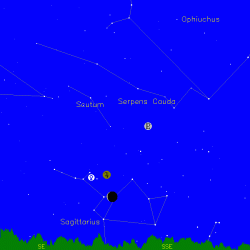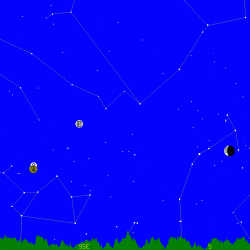Although no one likes getting up early, the morning of February 1 will be worth the effort. Just before local dawn, the scene is set as brilliant planets Venus and Jupiter rise together ahead of sunrise. The planetary pair will be so close together they can easily fit in the same binocular field of view and in a low power, wide field telescope eyepiece. Even if you don’t use optical aid, the dazzling duet will capture the eye….
“Your eye is like a digital camera,” explains Dr. Stuart Hiroyasu, O.D., of Bishop, California. “There’s a lens in front to focus the light, and a photo-array behind the lens to capture the image. The photo-array in your eye is called the retina. It’s made of rods and cones, the fleshy organic equivalent of electronic pixels.” Near the center of the retina lies the fovea, a patch of tissue 1.5 millimeters wide where cones are extra-densely packed. “Whatever you see with the fovea, you see in high-definition,” he says. The fovea is critical to reading, driving, watching television. The fovea has the brain’s attention. The field of view of the fovea is only about five degrees wide. On Friday morning, Venus and Jupiter will fit together inside that narrow angle, signaling to the brain, “this is worth watching!”
But Venus and Jupiter aren’t the only pair sparkling the pre-dawn skies. If you look a bit further south, you’ll notice that the waning Moon and Antares are also making a spectacular show! While they will be separated by a little more distance, the red giant and earthshine Moon will still fit within the eye’s fovea – and a binocular field of view!
 Where will all the celestial action take place? Look no further than the ecliptic plane – the imaginary path the Sun, Moon and planets take across the sky. For many observers, the ecliptic plane begins low in the southeast – but southern hemisphere viewers have a much different view! But don’t wait until Friday to have a look. If you’re up before dawn, step outside and watch as Venus and Jupiter draw closer together over the next several days and the Moon creeps to the east. On February 3, the Moon will form a line-up with the two planets and a striking triangle on the morning of February 4. Be sure to have a camera on hand and share your photos!
Where will all the celestial action take place? Look no further than the ecliptic plane – the imaginary path the Sun, Moon and planets take across the sky. For many observers, the ecliptic plane begins low in the southeast – but southern hemisphere viewers have a much different view! But don’t wait until Friday to have a look. If you’re up before dawn, step outside and watch as Venus and Jupiter draw closer together over the next several days and the Moon creeps to the east. On February 3, the Moon will form a line-up with the two planets and a striking triangle on the morning of February 4. Be sure to have a camera on hand and share your photos!
Wishing you clear skies….


Hi
i am soooooooooo exited to see the planets togather
i dono how it gonna like
but i m sure it is gonna b something cool to see!!!!!!
Can’t wait to see this grand conjunction :)!
If I get to see this with all the winter weather we have in Minnesota, it will be like winning the lottery.
Hmmm. If I do see it, maybe I should buy a ticket!
i cant wait but
where would it be if i was in Australia
Forecast for my location (outside of Atlanta, GA): Cloudy, with light morning rain.
Poop.
So long as the night of Feb 20th is clear, I’m good, though.
What’s the best time to see this event in Europe?
If you live in the Southern Hemisphere, the ecliptic plane is much further north… So you’re going to be looking for the conjunction to the northeast!
If you live in Europe, in the morning before dawn is just the same as in the morning before dawn for the United States. If you have an unobstructed horizon, you can see the pair rise about an hour before local dawn. If trees or houses obscure the horizon, about 30 minute before official sunrise.
Keep those binoculars handy, because the planet show is about to get even more exciting!!
Wishing you all clear skies,
~Tammy
PS – For those of you who are interested, the grey ball labeled PL is the position of Pluto!
if it will show on early february 1? what will it be here in asia? thanx!
specifically here in the philippines, thanx!
Gosh! I hope you were up early this morning!!!
Remember whenever you see a Sky Watching Tip, that it’s based on a universal date. That means eastern Europe, Australia, etc. has to calculate for a day earlier than the date given. If an event happens at a specific time, the terms are expressed in universal time.
A really cool gadget exists on Google home pages that allows you to put a “clock” on your homepage that shows the universal time and date. For those who enjoy astronomy events, it’s really cool and worth letting load.
If you missed this morning, don’t forget to try on the following mornings!
Light Speed,
~Tammy
Y’all might want to check out http://heavens-above.com/ . You can generate a sky chart for any location on earth, at any time you pick. VERY handy! And, FWIW, the Venus/Jupiter thing isn’t an exact moment; just go look toward the sunrise just before sunrise for the next few days.
nice shootin’, tex!!
i also high reccommend heavens above!
Dear all,
I live in the Southern Hemisphere and I saw the beautiful closeness between Jupiter and Venus on the 03/02/08. Even that was satisfactory as compared to what it was supposed to be on 01/02/08. How beautiful these two appear in the morning sky. Actually I saw them at 5.21 am in the SE.